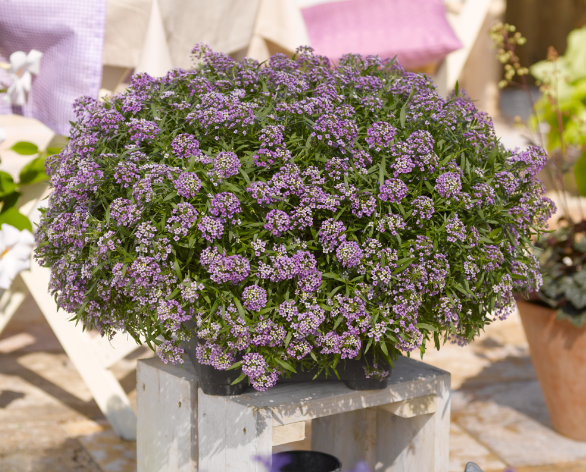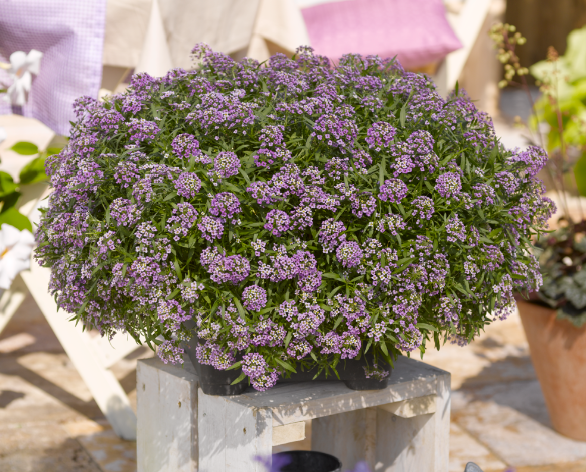
Crop Culture Report: Lobularia Stream Series
Lobularia Stream series is bred By Danziger and comes in four beautiful and fragrant colors — ‘Lavender Stream’, ‘Silver Stream’, ‘Summer Stream’ and ‘White Stream’. Two new varieties will be added for the 2013-14 season — ‘Purple Stream’, a dark purple that will not fade, and ‘Bicolor Lavender’, a mix of lavender, white and a hint of yellow. These two are also fragrant.
Lobularia Streams were bred to be to be heat tolerant and are well controlled in nature. They make a great addition to combination pots and blend well with other varieties. Lobularia Streams also have the garden performance to be planted as a bedding accent plant in the garden. They can handle early to late season and will add a scent of spring to any planting and in the garden center.
Rooting
Lobularia Streams are vegetative and should be stuck in the tray of your choice from an 84 tray to a 200 cell. Stick on arrival and place under mist. A fungicide to protect from Botrytis should be applied the day of sticking. Follow normal misting guidelines as you would bacopa or verbena. Soil temperature between 72° and 74° F should be maintained during the first six to eight days. Once roots are visible, reduce and remove from mist. At this time lower the temperature to 65° to 68° F. Feeding at this time should take place. An application of 100- to 150-ppm nitrogen is recommended. In the liner an EC of 0.9 to 1.0 should be maintained, if using a 2-to-1 soil test. If using a saturated paste, the numbers will be higher. Once rooted, pinch in the third week after sticking. The liner should be ready to transplant in four weeks.
Growing to Finish
Once the liner is finished transplant to the preferred container. Lobularia Streams can be grown in a large range of containers from 4-inch pots to 12-inch baskets and combinations. Transplant immediately after pulling from rooting area. Plant in a well drained soil that starts with a pH of 5.5 to 5.8. Spray after transplanting with a fungicide to protect from Botrytis. After transplanting fertilization can begin and should be done at 100- to 200-ppm nitrogen using a balanced feed. The fertilizer of your choice should be determined by the quality of your water. Maintain an EC of 1.2 to 1.4 and a pH of 5.8 to 6.0, using a 2-to-1 soil test when checking. Maintain a Daily average temperature of 65° to 68° F. Lobularia can be grown colder but time will need to be added to the finish time.
Timing
Finish time in a 4- to 41/2-inch pot should take four to six weeks to finish flowering depending on the temperature. Seven to eight weeks should be sufficient time to finish a 10- to 12-inch basket. Plants can be sold from early to late spring in most areas in the United States.
Plants Per Pot
Liners should be stuck one per cell.
4- to 5-inch pot: one plant
6-inch pot: two plants
8- to 10-inch pot: three plants
12-inch basket: four plants
Light
Lobularia are day neutral and will not need lighting to flower early. Supplemental lighting of liners can be beneficial to liner production in the northern states. Lighting should only be given up to 12 hours per day.
PGRs
Lobularia are responsive to most PGRs. When producing the liner a combination of B-Nine or B-Nine and A-Rest as a spray is recommended to tone the liner. Rates should be determined by reading the label and the vigor of the plant. When growing in larger containers a slightly more aggressive chemical like paclobutrazol can be used as a drench. This drench on large containers can be done at 1 ppm one week after transplanting in hanging basket or pot. Paclobutrazol can also be used to control all sizes. The rate should be determined by the label and plant vigor.
Pests and Fungus
Pests and funguses are something that needs to be protected against as with all plant species. A good spray program should be followed. Scouting is also very important and should be done on a weekly basis. Pests to watch for on lobularia are aphids, thrips, whitefly, fungus gnats and shore fly. Funguses that need to be controlled are Botrytis, Downey Mildew and Powdery mildew. Lobularia are not at high risk for most of these but still should be considered.
An impressive innovation in breeding, this series will make a great addition to any garden.




 Video Library
Video Library 




















